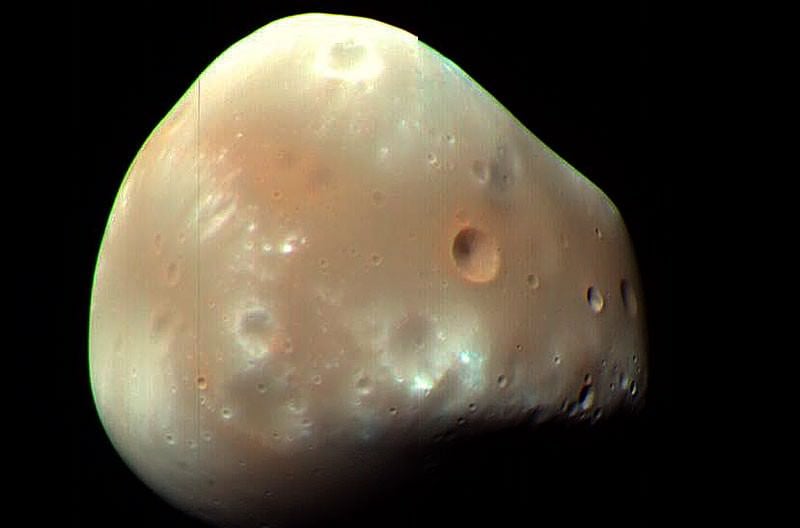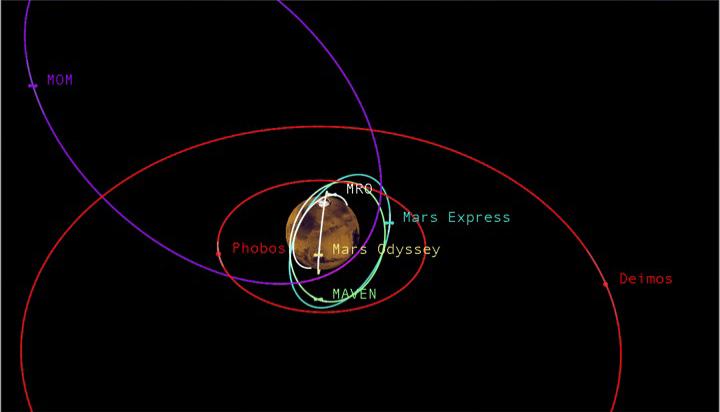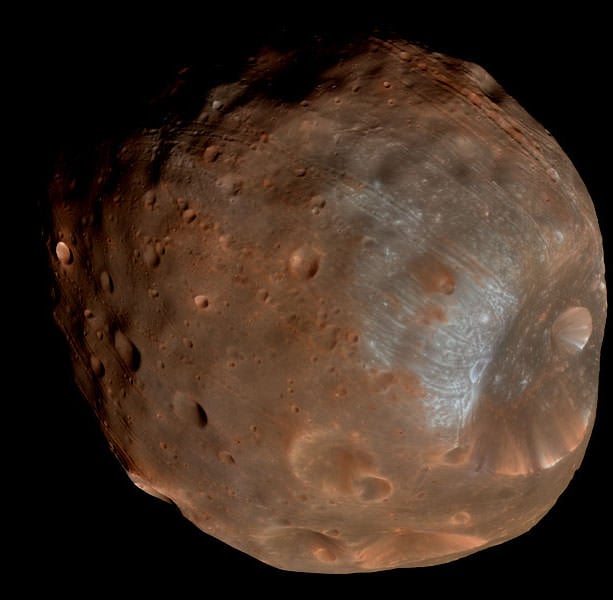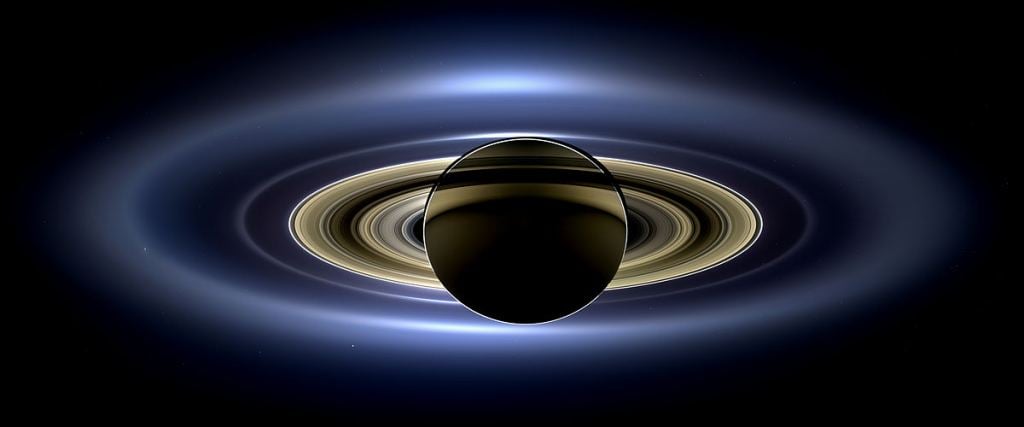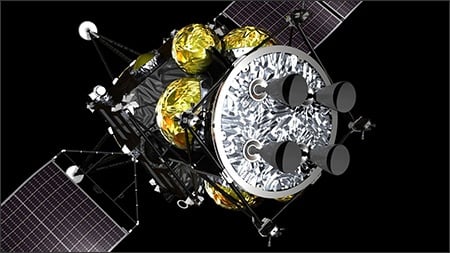Mars only has two moons: Phobos and Deimos. They're strange, for moons, little more than lumpy, potato-shaped chunks of rock. They're much too small for self-gravitation to have made them round. And one of them, Deimos, has an unusually tilted orbit.
What does that slight tilt tell us about Deimos? About Mars?
Deimos is the smaller of the two Martian Moons, and it's further from Mars than Phobos. Its orbital tilt is not huge: only two percent. That slight difference in tilt hasn't attracted too much of astronomers' attention over the years, because it doesn't seem significant.
"The fact that Deimos’s orbit is not exactly in plane with Mars’ equator was considered unimportant, and nobody cared to try to explain it."Matija Cuk, Lead Author, SETI Institute
Now a new paper explores that tilt, and arrives at an astonishing conclusion.
The paper is titled " Evidence for a Past Martian Ring from the Orbital Inclination of Deimos." Lead author is Matija Cuk, an astronomer and research scientist at the SETI Institute. The new paper will be published in The Astrophysical Journal Letters.
"The fact that Deimos's orbit is not exactly in plane with Mars' equator was considered unimportant, and nobody cared to try to explain it," said lead author Matija Cuk in a press release. Cuk is a research scientist at the SETI Institute. "But once we had a big new idea and we looked at it with new eyes, Deimos's orbital tilt revealed its big secret."
It's worth our time to take a look at the existing thinking around Martian moons. There are two main theories explaining how Mars got its moons: the impact hypothesis, and the captured asteroid hypothesis. The impact hypothesis says that another large body struck Mars in the distant past, ejecting debris into orbit, which coalesced into the Martian moons. That hypothesis says that the Martian moon system must have been larger in the past, with some of the material falling to the Martian surface.
The other is the captured asteroid hypothesis. Phobos and Deimos share many similarities with carbonaceous C-type asteroids. One drawback to that explanationn is the nearly circular orbits of both moons. Captured main-belt asteroids would have more elliptical orbits, so there would have to be some mechanism that circularized their orbits. Atmospheric drag and tidal forces could do that, but there likely hasn't been enough time.
In their paper, Cuk and his co-authors write "Two small satellites of Mars, Phobos and Deimos, are thought to have formed from debris ejected by a giant impact onto early Mars. The small masses of the satellites, compared to expectations from giant impact simulations, has lead to proposals that the original satellite system was more massive, with most of its mass falling onto Mars over several Gyr following the impact."
That's been the widely-held explanation for Phobos and Deimos.
In this new study, Mars' other moon Phobos plays a role, too. Back in 2017, David Minton, who is a co-author of this study, was a part of a different study into Phobos. That one was titled " An ongoing satellite–ring cycle of Mars and the origins of Phobos and Deimos," and was published in Nature Geoscience.
In that study, Minton and his co-author noted that Phobos was slowly getting closer and closer to Mars. Martian gravity was pulling it in, and there would be no escape. Eventually, Phobos' orbit would decay and it would cross the Roche Limit. Then, rather than plunge down to Mars to be destroyed, Martian gravity would tear tiny Phobos apart.
If you're thinking, "Wait a second. Wouldn't that create a ring of rocky debris around Mars?" then you're on the right track.
In the 2017 study, Minton and his co-author reasoned that there may have been many moons around Mars, and that generations of moons may have perished like this. But then the debris would have re-coalesced into another moon, and the cycle would've continued. Each time, the moon would be smaller.
So it's a big theory of cyclic, reincarnated Martian moons.
But back to Deimos and its two degrees of tilt, and the new study.
When a new moon forms from the debris of its destroyed ancestor, the new moon would move further away from the ring, and from Mars. So while Phobos is being pulled closer to Mars and its eventual destruction, the newly-formed moon would be moving outward. And as it did so, it would experience an orbital resonance just outside the rings. In Deimos' case, its orbital period is three times that of the other moon.
Orbital resonances are well-understood and predictable. Astronomers know that only an outward moving moon could have had a strong effect on Deimos. So that means that Mars must have had a ring of debris, forcing that moon outward.
"We find that Deimos’s inclination can be reliably generated by outward evolution of a Martian satellite that is about 20 times more massive than Phobos..."From the Paper "Evidence for a Past Martian Ring from the Orbital Inclination of Deimos."
Now, in this new study Cuk and the other researchers concluded that this other moon was about 20 times more massive than Phobos. It might have been its grandparent, and could have existed about three billion years ago, and was followed by two more cycles of this moon-ring phenomenon. The moon Phobos is the current artifact of the cycle.
In their paper they write "We find that Deimos's inclination can be reliably generated by outward evolution of a Martian satellite that is about 20 times more massive than Phobos through the 3:1 mean-motion resonance with
Deimos at 3.3 Mars radii."
That's a lot to digest, but it's supported by evidence and observation.
A press release states that "This insight from a modest tilt of a humble moon's orbit has some significant consequences for our understanding of Mars and its moons. The discovery of the past orbital resonance all but clinches the cyclic ring-moon theory for Mars."
So the ringless Mars we see today is probably an anomaly. We're in between rings right now, and we've assumed that's normal. Humanity keeps doing that.
One of the conclusions that follows from this work concerns the ages of Mars' two current moons. According to this study, Deimos is billions of years old, while Phobos is relatively young, perhaps only 200 million years old. As they write in their paper, "Our findings, combined with the model of Hesselbrock & Minton (2017), suggest that the age of the surface
of Deimos is about 3.5-4 Gyr, and require Phobos to be significantly younger."
Lead author Cuk acknowledges that this is all theoretical at this point. But maybe it won't be "just theoretical" for long. JAXA, the Japanese Space Agency, is planning a sample collection mission to Phobos in 2024. That mission is called MMX, Martian Moon Exploration. It will explore both of Mars' misshapen moons, and will collect a sample from Phobos.
According to JAXA, that mission has two overarching science objectives:
- Clarification of the origin of the Martian moons and the process of planet formation in the Solar System.
- Clarification of the evolution process of the Martian-sphere (Mars, Phobos, Deimos).
This mission was planned prior to any of this work into the Martian Moon/Dust-Ring cycle. JAXA says on their website that "There are two dominent theories as to the origin of the Martian moons: (A) the pair are asteroids captured after the formation of Mars or (B) the moons are fragments scattered during a giant collision (Giant Impact) with Mars that then coalesced. Based on the results of proximity observations and the analysis of collected samples, the most likely theory for the moons' formation can be clarified."
If Cuk and his colleague are right, then the MMX mission might discover more than JAXA bargained for.
More:
- Press Release: Martian Moon’s Orbit Hints at an Ancient Ring of Mars
- Research Paper: Evidence for a Past Martian Ring from the Orbital Inclination of Deimos
- Universe Today: Mars Express Takes Photos of Phobos as it Flies Past
 Universe Today
Universe Today

